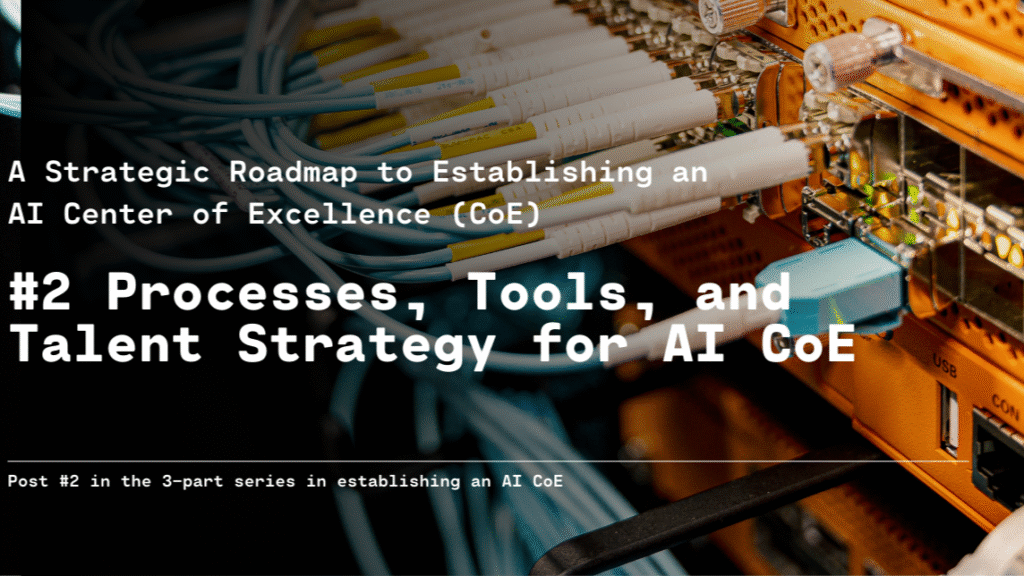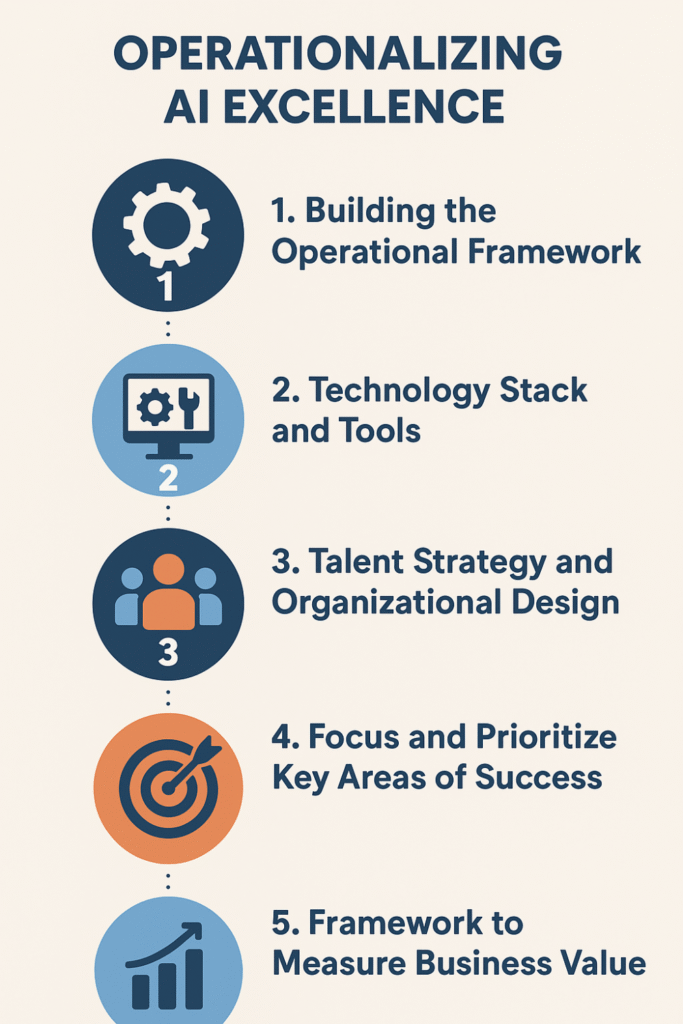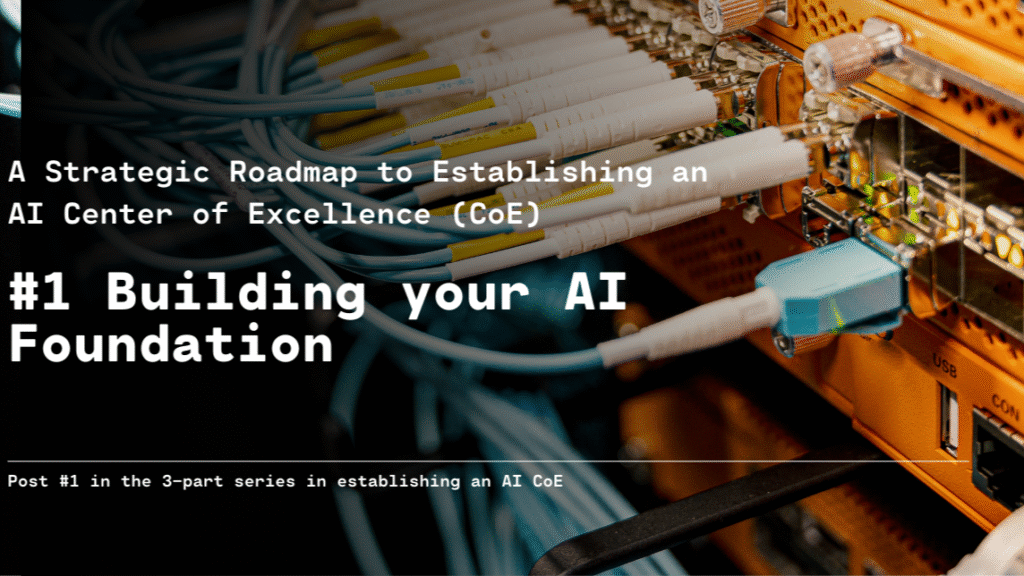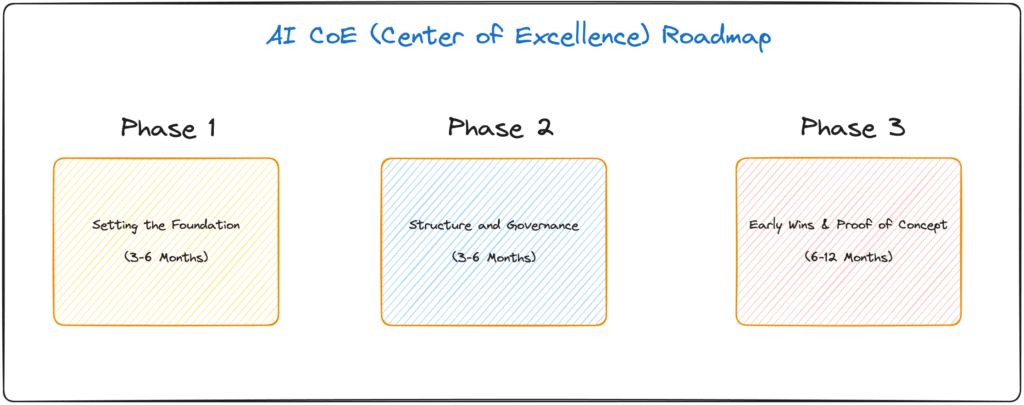This article is part of a 3-part series on a strategic roadmap to establish your AI Center of Excellence (CoE). You can read the first and second posts here.
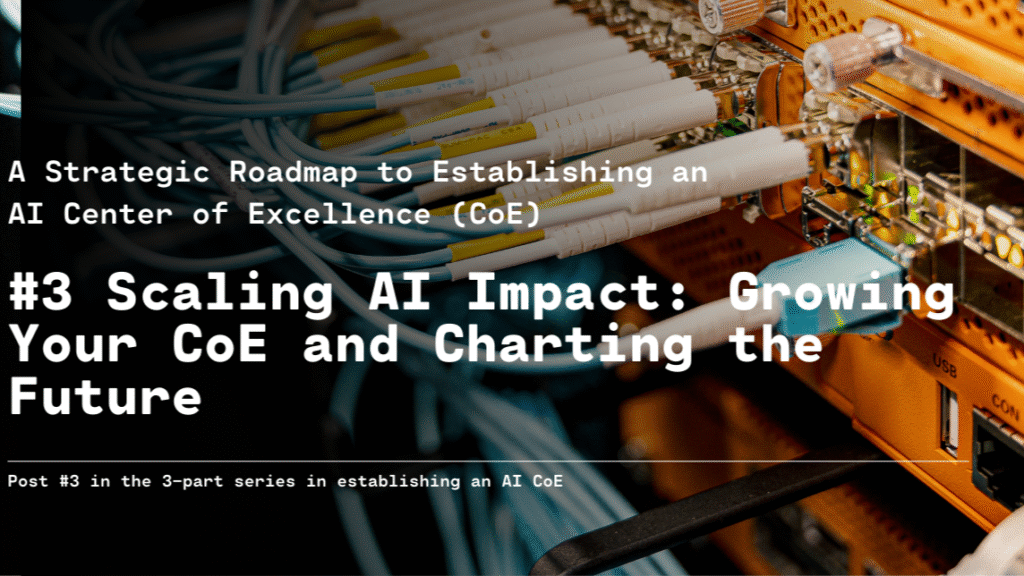
The journey of an AI Center of Excellence (CoE) typically begins with promising pilots and initial successes. Yet, the true measure of an AI CoE’s impact lies not just in these early wins, but in its ability to scale those successes across the organization, transforming isolated projects into pervasive, enterprise-wide capabilities. This isn’t merely about doing more AI; it’s about doing AI better, more efficiently, and with greater strategic alignment.
This article, the third in our series, delves into how an AI CoE can move beyond initial triumphs to achieve broad-based impact. We’ll start by exploring the critical steps involved in Expanding Scope and Scale, transforming successful proofs-of-concept into industrial-grade solutions and broadening AI’s reach across the enterprise.
From Pilots to Production at Scale: Industrializing AI
Many organizations find themselves stuck in “pilot purgatory” – an abundance of promising AI prototypes that never quite make it to full-scale production. Overcoming this is arguably the most significant challenge in scaling AI impact. It requires a fundamental shift in mindset and methodology, moving from agile experimentation to robust industrialization.
Industrializing Successful Proof of Concepts
The transition from a successful proof-of-concept (PoC) to a production-ready solution is fraught with challenges. A PoC is designed to validate an idea; a production system must be reliable, scalable, secure, and maintainable. This shift requires a rigorous process of industrialization.
- Robust Engineering Principles: This means applying software engineering best practices to AI development. Version control isn’t just for code; it’s for data, models, and configurations. Automated testing should cover data quality, model performance, and integration points. Code reviews and documentation become non-negotiable.
- Performance and Scalability: A PoC might work with a small dataset on a single machine. Production demands handling massive data volumes, processing requests with low latency, and scaling dynamically with demand. This often involves re-architecting solutions to leverage distributed computing, cloud-native services, and optimized model serving infrastructure.
- Security and Compliance: Production AI systems must adhere to the organization’s security protocols and relevant regulatory compliance standards (e.g., GDPR, HIPAA, PDPA in Singapore). This includes secure data handling, model access control, audit trails, and vulnerability management.
- Maintainability and Observability: Production systems need to be easily monitored, debugged, and updated. This involves instrumenting models and pipelines with logging, metrics, and alerts. A clear incident response plan for model degradation or failure is crucial.
Building Repeatable Deployment Frameworks
To move beyond one-off deployments, CoEs must develop repeatable deployment frameworks. This is where MLOps (Machine Learning Operations) truly shines, providing the backbone for industrializing AI.
- Standardized CI/CD Pipelines for ML: Just as DevOps revolutionized software delivery, MLOps streamlines the continuous integration, continuous delivery, and continuous deployment of machine learning models. This means automating the process from model training and validation to deployment and monitoring.
- Containerization and Orchestration: Using technologies like Docker for containerizing models and their dependencies, combined with Kubernetes for orchestration, enables consistent deployment across different environments (development, staging, production) and efficient scaling.
- Model Registries and Versioning: A centralized model registry serves as a single source of truth for all trained models, their versions, metadata, and performance metrics. This allows for easy tracking, comparison, and rollback if needed.
- Automated Monitoring and Alerting: Deploying a model is not the end; it’s the beginning of its lifecycle. Automated monitoring systems should track model performance (accuracy, latency, drift), data quality, and infrastructure health. Alerts should be triggered when performance degrades or anomalies are detected, prompting re-training or intervention.
Managing Increased Complexity and Volume
As the number of AI applications grows, so does the operational complexity. A CoE must evolve its strategies to manage this increased volume.
- Centralized Management Plane: A unified dashboard or platform to oversee all deployed models, their status, performance, and resource consumption becomes essential. This provides a holistic view and facilitates proactive management.
- Resource Allocation and Cost Optimization: Scaling AI means consuming more computational resources. The CoE needs robust processes for allocating GPU time, cloud compute, and storage, along with strategies for cost optimization (e.g., leveraging spot instances, right-sizing resources).
- Knowledge Management and Documentation: As more models are deployed, comprehensive documentation for each – detailing its purpose, data sources, training methodology, performance characteristics, and known limitations – becomes critical for future maintenance, auditing, and knowledge transfer.
- Dedicated Operations Teams: For larger CoEs, a dedicated MLOps or AI Operations team may be necessary. This team focuses specifically on the reliability, scalability, and performance of production AI systems, allowing data scientists and ML engineers to concentrate on model development.
Broadening Domain Coverage: Extending AI’s Reach
Once the CoE demonstrates its ability to reliably industrialize AI solutions, the next natural step is to broaden its impact by extending AI’s application into new business areas. This involves strategic expansion, fostering collaboration, and driving enterprise-wide standardization.
Expanding into New Business Areas
Initial AI successes often cluster around specific pain points or enthusiastic business units. Scaling impact means intentionally seeking out and penetrating new domains.
- Strategic Opportunity Mapping: Proactively identify business units or functions that could benefit significantly from AI, even if they haven’t explicitly requested it. This requires deep business understanding and a consultative approach.
- Value-Driven Prioritization: Continue to prioritize new use cases based on clear business value (e.g., revenue generation, cost reduction, risk mitigation) and technical feasibility, using a consistent framework across the organization.
- Building Trust and Advocacy: Each successful project in a new domain builds trust and creates internal advocates for AI. These advocates become crucial in driving further adoption.
Cross-Functional Collaboration Models
As AI expands, the CoE cannot operate in a vacuum. Effective cross-functional collaboration becomes paramount.
- Embedded Teams or Liaisons: Consider embedding data scientists or AI solution architects within key business units for a period. This fosters deeper domain understanding and strengthens relationships. Alternatively, appoint AI liaisons from the CoE to specific business units to act as conduits for requirements and insights.
- Shared Objectives and KPIs: Align AI project objectives and key performance indicators (KPIs) with the strategic goals of the collaborating business units. This ensures that AI initiatives are directly contributing to shared success.
- Joint Steering Committees: Establish steering committees with representatives from the CoE and key business stakeholders to oversee the AI roadmap, resolve bottlenecks, and ensure strategic alignment.
- Federated Models of Execution: As the organization matures, a “federated” AI model might emerge, where individual business units develop their own AI capabilities while the central CoE provides governance, shared platforms, and expertise. This requires clear interfaces and communication channels.
Enterprise-Wide AI Standardization
To avoid fragmentation and technical debt as AI proliferates, the CoE must drive enterprise-wide standardization.
- Common Tooling and Platforms: While flexibility is good, too many disparate tools can hinder collaboration and increase operational overhead. The CoE should define recommended or mandatory tools for data science, MLOps, and deployment.
- Best Practices and Guidelines: Publish clear guidelines for data governance, model development, responsible AI practices, and security. This ensures consistency and quality across all AI initiatives, regardless of where they originate.
- Shared Data Assets: Work with data governance teams to establish shared, high-quality data assets that can be leveraged by multiple AI projects across different domains. This avoids redundant data preparation efforts and ensures data consistency.
- Knowledge Sharing Platforms: Implement internal wikis, forums, or regular “AI show-and-tell” sessions to facilitate knowledge sharing, disseminate best practices, and foster a sense of community among AI practitioners across the organization.
This concludes the 3-part series on strategizing, implementing and scaling AI CoE (Center of Excellence) in your organization. It is a long and arduous journey, and these posts will give a head start to a tech leader like you!
In case you missed the other posts, you can read them here – first and second post.
